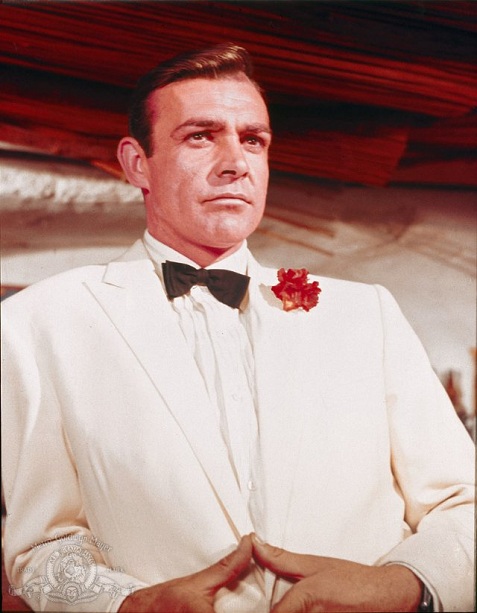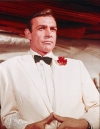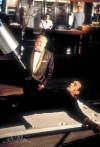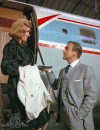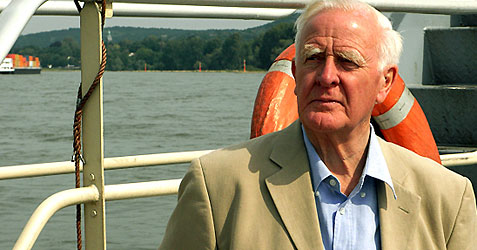Bullz-Eye continues its look back at every James Bond film, 007 One by One, as part of our James Bond Fan Hub that we’ve created to celebrate the 50th anniversary of the first Bond film.
The third Bond film is more than one of the most enduringly popular movies in the series, it’s the template for James Bond movies from that point forward. In fact, it’s fair to argue that it actually set the pattern for actions films for years to come. It was also arguably the first modern-day blockbuster in that it was intended as an event as well a movie — complete with mega-bucks generating merchandizing opportunities. Sadly, it’s also the first movie in the series that Bond’s 56 year-old creator, Ian Fleming, didn’t live to see completed. He could not have conceived of how insanely popular his creation would become within months of his passing.
“Goldfinger” (1963)
The Plot
007 locks deadly horns with a mysterious millionaire known for cheating at gin rummy, golf, and the exportation of gold. That naturally turns out to be only the tip of the iceberg as James Bond discovers a diabolical plan aimed at destroying the economy of the free world and making portly Auric Goldfinger (Gert Fröbe) the world’s richest man. The aptly named, gold-obsessed supervillain’s target is, of course, Fort Knox.
The Backstory
With the back-to-back success of “Dr. No” and “From Russia With Love,” the cash-conscious EON producing team of Harry Saltzman and Albert R. “Cubby” Broccoli were ready to spend big money in early 1960’s movie production terms — $3 million! (The 2008 Bond entry, “Quantum of Solace,” had a reported production budget of $200 million.)
Dashing director Terrence Young, who had launched the series so ably with “Dr. No” and “From Russia With Love,” went for the gold and held out for more pay. True to form, EON decided to go with a more thrifty option and brought in an accomplished journeyman director who was, nevertheless, a new hand when it came to staging elaborate action scenes, Guy Hamilton.
American writer Richard Maibum was back on board, this time with an assist from British screenwriter Paul Dehn. A likely inspiration for the dashing English spy played by Michael Fassbender in “Inglourious Basterds,” Dehn was a former film critic and admitted World War II assassin. His next gig was, ironically, helping to adapt John le Carré’s specifically anti-Bondian espionage classic, “The Spy Who Came in From the Cold.”
Most importantly to the financial bottom line, Sean Connery had made himself synonymous with 007 and was also on board for another go round, though he wouldn’t appear on set until he finished off his highly dramatic starring role in Alfred Hithcock’s “Marnie.” Connery was starting to worry a little about this whole business of being typecast as a veritable superhero; he would continue to go out of his way to remind the public he could be someone other than Bond.
Researching the film today, everyone working on “Goldfinger” seems to have understood the massive opportunity it presented. That bigger budget meant one thing: more — more action, more gadgets, more violence, and an extremely fast pace by the standards of its day. It was just the kind of wretched excess that could lead to a film so enormous it could launch easily the longest lasting and most consistently successful franchise in movie history.
The Bond Girls (Rule of 3 + 2)
Bond keeps to his usual score of three sex partners per movie. However, as befits the more lavish “Goldfinger,” we actually have five legitimate “Bond girls” this go-round. It’s just that Bond respectfully keeps his hands off of one and apparently never quite reaches home plate with another. To be specific…
Bonita (Nadia Regan) — She gets kissed while naked at the end of the pre-credit sequence, but it appears that actually doing the deed with Bond was never in the treacherous beauty’s plans, and she ends up with only a nasty bump on the head for her trouble. The adorable, Serbian-born Nadia Regan was actually on her second Bond go-round, having played a very brief kittenish role in the just-prior, “From Russia With Love,” where she was the Turkish secretary/girlfriend of Ali Kerim Bey (Pedro Armendariz.)
Dink (Margaret Nolan) – This lovely bathing beauty and amateur masseuse appears to be Bond’s very temporary girlfriend during his very short vacation at Miami Beach’s ultra-lux Fontainebleau Hotel. In true super-sexist style, he dismisses her with jovial rudeness and a smart smack to the backside when his American colleague shows up. Actress and model Margaret Nolan would go on to appear in a Playboy pictorial and several entries in the “Carry On” series of British sex comedies.

Jill Masterson (Shirley Eaton) – Bond wastes little time in seducing the bikini clad Masterson, who has unwisely taken a job helping a certain highly suspicious gold broker cheat at gin rummy. The superspy clearly takes a liking to the spunky, frankly sexual Masterson. He is devastated when he wakes up from a clubbing-induced slumber to find her suffocated to death by being painted completely gold from head to foot. It’s a tragic death, but it gave the movie its poster and one of the most creepily memorable and iconic images in the Bond lexicon. Shirley Eaton, already a busy working actress in the British film industry, would go on to star in a number of mostly not-so-distinguished films before retiring in favor of motherhood in 1969. She came out of retirement three decades later with a memoir, Golden Girl.
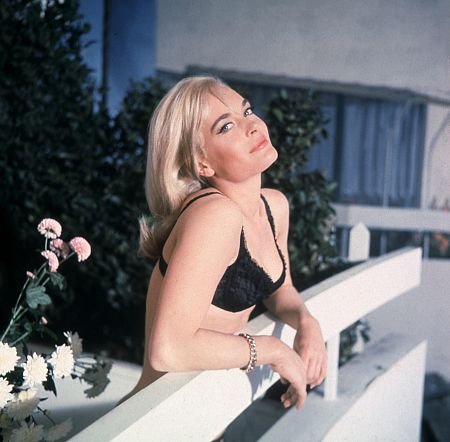
You can follow us on Twitter and Facebook for content updates. Also, sign up for our email list for weekly updates and check us out on Google+ as well.
Posted in: Entertainment, Movies
Tags: 007, 007 50th anniversary, 007 films, 007 gadgets, 007 movies, 007 One by One, 007 one-liners, 007 villains, Albert R. "Cubby" Broccoli, Aston Martin DB5, Aston Martin DB5 James Bond, Auric Goldfinger, beautiful Bond women, best Bond movie moments, Bond babes, Bond films, Bond gadgets, Bond girls, Bond movies, Bond one by one, Bond villains, Bonita, Cec Linder, classic Bond gadgets, cognac, Corgi DB5, Desmond Llewelyn, Desmond Llewelyn Q, Dink, Felix Leiter, Fontainebleau Hotel, Gert Fröbe, Goldfinger, Goldprick, Guy Hamilton, Harold Sakata, Harry Saltzman, Honor Blackman, iconic James Bond moments, James Bond, James Bond 007, James Bond 50th anniversary, James Bond actresses, James Bond babes, James Bond blog, James Bond cars, James Bond craze, James Bond drinks, James Bond franchise, James Bond girls, James Bond henchmen, James Bond hookups, James Bond mint julep, James Bond movies, James Bond music, James Bond nemesis, James Bond one-liners, James Bond romantic endings, James Bond villains, James Bond violence, Jill Masterson, license to kill, M Bond, Margaret Nolan, martini shaken not stirred, memorable Bond scenes, Miami Beach, Moneypenny, movie blockbusters, movie merchandizing, movie one-liners, Nadia Regan, Oddjob, Paul Dehn, Pussy Galore, Richard Maibum, Sean Connery, Shirley Eaton, supervillains, Tania Mallet, Tilly Masterson




